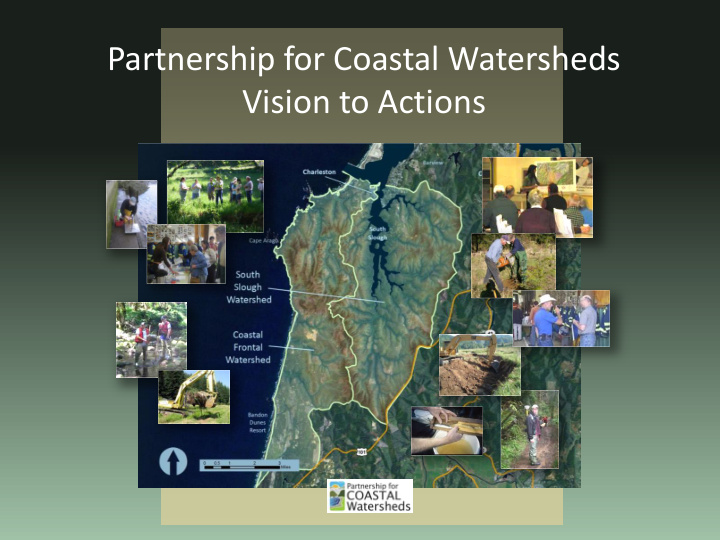



Partnership for Coastal Watersheds Vision to Actions
South Slough NERR and Coos Watershed Association Monitoring Infrastructure (plus NOAA) Additional data from many partners: ODFW, DEQ, ODF, USFS, NAMPAN, NOAA…etc.
Water Habitat Living Resources • 2008 Resource Condition • • 2008 Resource Condition 2008 Resource Condition Scorecard- Water Scorecard- Habitat Scorecard- Living Resources • Estuarine Water Quality • • Stream Habitat- Aquatic Salmon in the project area Habitat Inventory • Stream Water Quality • Dungeness crabs • Eelgrass Bed Distribution and • • Recreational clams Special Issue- pH shift in the Density South Slough Estuary • Birds in the County • Tidal Wetlands • Local Tide Heights • (Large Mammals- not yet • (Forest Health in the Project completed) • Sediment Sources Area – not yet completed) • (Contaminants- not yet • (Freshwater Wetlands- not yet completed) completed) • (Stream Hydrology- not yet completed)
Controlling Factors Local Tide Height: Trend in mean tide height recorded at NOAA CO-OPS Tide Station NOAA’s tide station in Monitoring Effort: High Charleston Funding Source: NOAA Summary: Based on 36 years of continuous tidal data, the mean tidal height at the Charleston tide station is rising at a rate of ~ 1.3 mm per year . Why do we care: Sea level rise will cause increased frequency of coastal flooding and associated erosion sometime in the future. This trend does not take into account the likelihood of sea level rise acceleration due to thermal expansion of the ocean and other factors .
Controlling Factors Medford Climate: Local and regional NOAA Weather Service stations, NB Airport, Medford air temperature trends Monitoring Effort: High Funding Source: NOAA Summary: Annual average Weather Service maximum temperatures in North Bend have dropped since 1902; the biggest drop PDO PDO Pacific Decadal Oscillation Warming? Warming? being in summer max temps. (PDO) Cooling? Maximum temperatures have increased inland at Medford, OR. Why do we care: The temperature difference between the valley and the coast is a key controlling factor regulating summertime north winds on the coast. Strong north winds cause coastal upwelling which brings cool ocean waters to the surface along the coast, cooling coastal areas and frequently produces fog.
Controlling Factors Invasive Species: Trends in species invasions and eradication success Invasive species are found throughout the project area. Summary: 2008 resource condition assessment: “Alien NZ Mud species have caused or are Snail likely to cause severe declines in some but not all ecosystem components and reduce ecosystem integrity. “ Why do we care: Invasive species cause ecological and economic damage to natural and developed landscapes. Purple Loosestrife Assiminea Gorse parasitologica
Controlling Factors Land Use: Historic and anticipated changes in land use in the project area Summary: Nearly 85% of all land in the partnership project area is zoned as either harvestable or conservation forest. Residential and commercial land each cover 5% while industrial zoning is the lowest land-use category represented, at 0.04%. Why do we care: Zoning boundaries indicate the current extent possible for different forms of development. By analyzing how different zones are geographically located and grouped, we can visualize maximum build-out scenarios in our community.
Influence of Controlling Factors on Environmental Actions (e.g.) Climate Change • Habitat simplification/degradation (invasive species) - > Re-establish habitat complexity using “climate - sensitive” species • Habitat elimination or conversion - > Plan for habitat and species migrations (e.g., tidal wetlands, eelgrass beds); protect vulnerable habitats (e.g., key habitats threatened by coastal erosion or disease) • Confusion about local effects of climate change - > Develop scenarios describing the most likely local effects of climate change; assess local “vulnerabilities”
Influence of Controlling Factors on Environmental Actions (e.g.) Climate Change • Habitat simplification/degradation (invasive species) - > Re-establish habitat complexity using “climate - sensitive” species • Habitat elimination or conversion - > Plan for habitat and species migrations (e.g., tidal wetlands, eelgrass beds); protect vulnerable habitats (e.g., key habitats threatened by coastal erosion or disease) • Confusion about local effects of climate change - > Develop scenarios describing the most likely local effects of climate change; assess local “vulnerabilities” Land Use (historic) • Habitat simplification - > Re-establish habitat complexity* • Habitat elimination or conversion - > Re-establish habitat • Habitat degradation (pollution) - > Eliminate or reduce source/remove contaminants *Includes invasive species
Influence of Controlling Factors on Environmental Actions (e.g.) Climate Change • Habitat simplification/degradation (invasive species) - > Re-establish habitat complexity using “climate - sensitive” species • Habitat elimination or conversion - > Plan for habitat and species migrations (e.g., tidal wetlands, eelgrass beds); protect vulnerable habitats (e.g., key habitats threatened by coastal erosion or disease) • Confusion about local effects of climate change - > Develop scenarios describing the most likely local effects of climate change; assess local “vulnerabilities” Land Use (historic) • Habitat simplification - > Re-establish habitat complexity* • Habitat elimination or conversion - > Re-establish habitat • Habitat degradation (pollution) - > Eliminate or reduce source/remove contaminants *Includes invasive species Land Use (developing/anticipated) • Habitat simplification - > Minimize habitat simplification • Habitat elimination or conversion - > Minimize habitat change • Habitat degradation (pollution) - > Eliminate or minimize contaminant source(s)
Recommend
More recommend